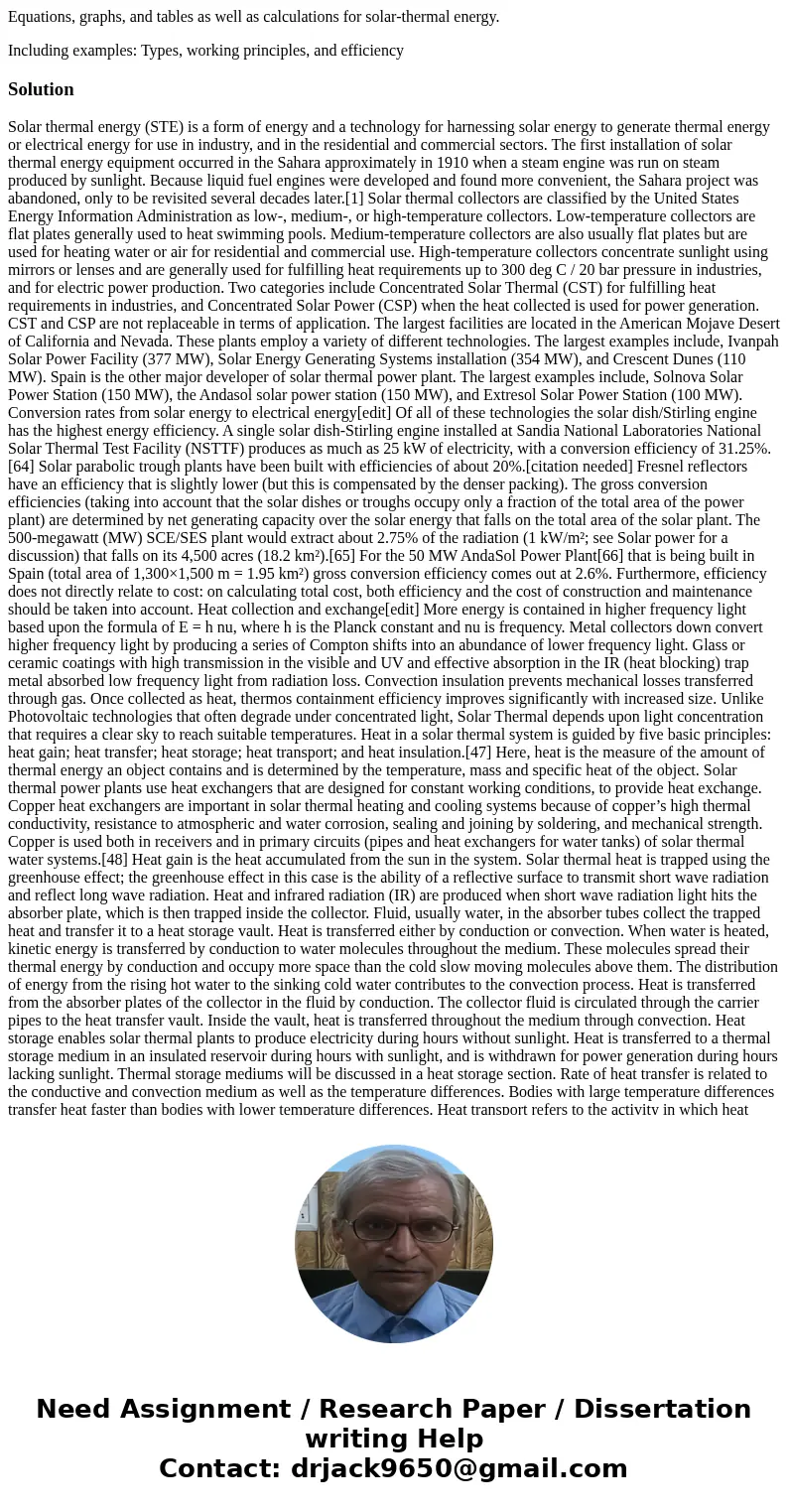Equations graphs and tables as well as calculations for sola
Equations, graphs, and tables as well as calculations for solar-thermal energy.
Including examples: Types, working principles, and efficiency
Solution
Solar thermal energy (STE) is a form of energy and a technology for harnessing solar energy to generate thermal energy or electrical energy for use in industry, and in the residential and commercial sectors. The first installation of solar thermal energy equipment occurred in the Sahara approximately in 1910 when a steam engine was run on steam produced by sunlight. Because liquid fuel engines were developed and found more convenient, the Sahara project was abandoned, only to be revisited several decades later.[1] Solar thermal collectors are classified by the United States Energy Information Administration as low-, medium-, or high-temperature collectors. Low-temperature collectors are flat plates generally used to heat swimming pools. Medium-temperature collectors are also usually flat plates but are used for heating water or air for residential and commercial use. High-temperature collectors concentrate sunlight using mirrors or lenses and are generally used for fulfilling heat requirements up to 300 deg C / 20 bar pressure in industries, and for electric power production. Two categories include Concentrated Solar Thermal (CST) for fulfilling heat requirements in industries, and Concentrated Solar Power (CSP) when the heat collected is used for power generation. CST and CSP are not replaceable in terms of application. The largest facilities are located in the American Mojave Desert of California and Nevada. These plants employ a variety of different technologies. The largest examples include, Ivanpah Solar Power Facility (377 MW), Solar Energy Generating Systems installation (354 MW), and Crescent Dunes (110 MW). Spain is the other major developer of solar thermal power plant. The largest examples include, Solnova Solar Power Station (150 MW), the Andasol solar power station (150 MW), and Extresol Solar Power Station (100 MW). Conversion rates from solar energy to electrical energy[edit] Of all of these technologies the solar dish/Stirling engine has the highest energy efficiency. A single solar dish-Stirling engine installed at Sandia National Laboratories National Solar Thermal Test Facility (NSTTF) produces as much as 25 kW of electricity, with a conversion efficiency of 31.25%.[64] Solar parabolic trough plants have been built with efficiencies of about 20%.[citation needed] Fresnel reflectors have an efficiency that is slightly lower (but this is compensated by the denser packing). The gross conversion efficiencies (taking into account that the solar dishes or troughs occupy only a fraction of the total area of the power plant) are determined by net generating capacity over the solar energy that falls on the total area of the solar plant. The 500-megawatt (MW) SCE/SES plant would extract about 2.75% of the radiation (1 kW/m²; see Solar power for a discussion) that falls on its 4,500 acres (18.2 km²).[65] For the 50 MW AndaSol Power Plant[66] that is being built in Spain (total area of 1,300×1,500 m = 1.95 km²) gross conversion efficiency comes out at 2.6%. Furthermore, efficiency does not directly relate to cost: on calculating total cost, both efficiency and the cost of construction and maintenance should be taken into account. Heat collection and exchange[edit] More energy is contained in higher frequency light based upon the formula of E = h nu, where h is the Planck constant and nu is frequency. Metal collectors down convert higher frequency light by producing a series of Compton shifts into an abundance of lower frequency light. Glass or ceramic coatings with high transmission in the visible and UV and effective absorption in the IR (heat blocking) trap metal absorbed low frequency light from radiation loss. Convection insulation prevents mechanical losses transferred through gas. Once collected as heat, thermos containment efficiency improves significantly with increased size. Unlike Photovoltaic technologies that often degrade under concentrated light, Solar Thermal depends upon light concentration that requires a clear sky to reach suitable temperatures. Heat in a solar thermal system is guided by five basic principles: heat gain; heat transfer; heat storage; heat transport; and heat insulation.[47] Here, heat is the measure of the amount of thermal energy an object contains and is determined by the temperature, mass and specific heat of the object. Solar thermal power plants use heat exchangers that are designed for constant working conditions, to provide heat exchange. Copper heat exchangers are important in solar thermal heating and cooling systems because of copper’s high thermal conductivity, resistance to atmospheric and water corrosion, sealing and joining by soldering, and mechanical strength. Copper is used both in receivers and in primary circuits (pipes and heat exchangers for water tanks) of solar thermal water systems.[48] Heat gain is the heat accumulated from the sun in the system. Solar thermal heat is trapped using the greenhouse effect; the greenhouse effect in this case is the ability of a reflective surface to transmit short wave radiation and reflect long wave radiation. Heat and infrared radiation (IR) are produced when short wave radiation light hits the absorber plate, which is then trapped inside the collector. Fluid, usually water, in the absorber tubes collect the trapped heat and transfer it to a heat storage vault. Heat is transferred either by conduction or convection. When water is heated, kinetic energy is transferred by conduction to water molecules throughout the medium. These molecules spread their thermal energy by conduction and occupy more space than the cold slow moving molecules above them. The distribution of energy from the rising hot water to the sinking cold water contributes to the convection process. Heat is transferred from the absorber plates of the collector in the fluid by conduction. The collector fluid is circulated through the carrier pipes to the heat transfer vault. Inside the vault, heat is transferred throughout the medium through convection. Heat storage enables solar thermal plants to produce electricity during hours without sunlight. Heat is transferred to a thermal storage medium in an insulated reservoir during hours with sunlight, and is withdrawn for power generation during hours lacking sunlight. Thermal storage mediums will be discussed in a heat storage section. Rate of heat transfer is related to the conductive and convection medium as well as the temperature differences. Bodies with large temperature differences transfer heat faster than bodies with lower temperature differences. Heat transport refers to the activity in which heat from a solar collector is transported to the heat storage vault. Heat insulation is vital in both heat transport tubing as well as the storage vault. It prevents heat loss, which in turn relates to energy loss, or decrease in the efficiency of the system. Heat storage for space heating[edit] Main article: Seasonal thermal energy storage A collection of mature technologies called seasonal thermal energy storage (STES) is capable of storing heat for months at a time, so solar heat collected primarily in Summer can be used for all-year heating. Solar-supplied STES technology has been advanced primarily in Denmark,[49] Germany,[50] and Canada,[51] and applications include individual buildings and district heating networks. Drake Landing Solar Community in Alberta, Canada has a small district system and in 2012 achieved a world record of providing 97% of the a community\'s all-year space heating needs from the sun.[52] STES thermal storage mediums include deep aquifers; native rock surrounding clusters of small-diameter, heat exchanger equipped boreholes; large, shallow, lined pits that are filled with gravel and top-insulated; and large, insulated and buried surface water tanks. Heat storage to stabilize solar-electric power generation[edit] Heat storage allows a solar thermal plant to produce electricity at night and on overcast days. This allows the use of solar power for baseload generation as well as peak power generation, with the potential of displacing both coal- and natural gas-fired power plants. Additionally, the utilization of the generator is higher which reduces cost. Heat is transferred to a thermal storage medium in an insulated reservoir during the day, and withdrawn for power generation at night. Thermal storage media include pressurized steam, concrete, a variety of phase change materials, and molten salts such as calcium, sodium and potassium nitrate.[53][54] Steam accumulator[edit] The PS10 solar power tower stores heat in tanks as pressurized steam at 50 bar and 285 °C. The steam condenses and flashes back to steam, when pressure is lowered. Storage is for one hour. It is suggested that longer storage is possible, but that has not been proven yet in an existing power plant.


 Homework Sourse
Homework Sourse